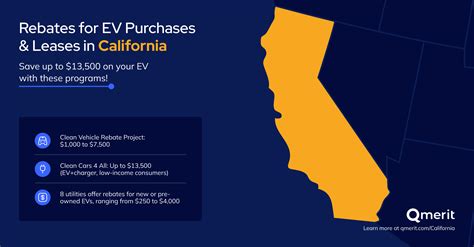As one of the most progressive states in the United States, California has long been at the forefront of environmental policies and innovations. One of the most significant measures taken by the state to combat climate change and encourage the adoption of cleaner vehicles is its Electric Vehicle (EV) rebate program. This program, initiated by the California Air Resources Board (CARB), aims to increase the adoption of electric vehicles across the state and minimize greenhouse gas emissions. The impact of these rebates is transforming not only the automotive landscape but also influencing consumer behavior and shaping the future of transportation.
The Landscape of California’s EV Rebates
California’s EV rebate program comes in various forms, including direct rebates for the purchase of new electric vehicles, incentives for low-income households, and funding for EV charging infrastructure. The primary incentive is the Clean Vehicle Rebate Project (CVRP), which offers rebates of up to $7,000 for eligible electric and plug-in hybrid vehicles. The program has been instrumental in encouraging consumers to consider electric alternatives over traditional gasoline-powered vehicles.
Moreover, California has implemented additional financial incentives, such as the Clean Fuel Reward program, which offers rebates for EV charging at home, making ownership more feasible and attractive for residents. Federal tax credits and local utility incentives further amplify these efforts, making California a leader in the EV market.
Driving Adoption of Electric Vehicles
The introduction of these rebates has led to a substantial increase in electric vehicle adoption in California. Since the program’s inception, hundreds of thousands of rebates have been issued, significantly contributing to the state’s ambitious goal of having 1.5 million zero-emission vehicles (ZEVs) on the road by 2025.
Statistics indicate that EV sales in California accounted for over 8% of all new vehicle sales in 2020, a notable leap from less than 2% just a few years earlier. This shift not only reflects changing consumer preferences but is also a direct result of the economic incentives provided by the state. Many consumers are increasingly seeking vehicles that offer lower operational costs, and EVs typically provide savings through reduced maintenance expenses and fuel costs.
Environmental Impact and Sustainability Goals
California’s rebates are not just about economic incentives; they are part of a broader strategy aimed at reducing carbon emissions and addressing climate change. Transportation is a major contributor to greenhouse gas emissions in the state, and the transition to EVs is critical for meeting California’s climate goals.
The state has set targets to achieve carbon neutrality by 2045 and to reduce greenhouse gas emissions by 40% below 1990 levels by 2030. By bolstering the EV market, California is making significant strides in reaching these targets. The widespread adoption of electric vehicles directly contributes to cleaner air in urban regions, where air quality is often compromised by vehicle emissions.
Transforming the Automotive Industry
The impact of California’s EV rebate program extends beyond consumer adoption; it is revolutionizing the automotive industry at large. Automakers are investing heavily in electric vehicle technology and infrastructure to comply with state regulations and to meet the rising consumer demand for EVs. Major manufacturers like Tesla, General Motors, and Ford have ramped up their EV production, introducing new models that cater to various consumer preferences and budgets.
Additionally, the shift toward electrification has prompted automotive companies to innovate faster, leading to advancements in battery technology, autonomous driving features, and smart vehicle connectivity. As competition heats up in the EV market, consumers benefit from increased choices, better technology, and more affordable options.
Challenges and Future Prospects
While the success of California’s EV rebates is commendable, several challenges remain. The upfront cost of electric vehicles is still higher than traditional vehicles, even when rebates are applied. Though this price gap is narrowing as technology advances, continued efforts are necessary to make EVs accessible to all, especially low-income households.
Moreover, the state faces hurdles in expanding charging infrastructure. To make EV adoption viable, California must develop a robust network of charging stations to alleviate range anxiety among consumers. Investments in public charging infrastructure and incentives for home charging installations are vital steps in addressing this challenge.
Conclusion
California’s EV rebate program is a shining example of how state policies can drive significant changes in consumer behavior, industry practices, and environmental outcomes. By making electric vehicles more accessible and appealing, the state is not only fostering a new automotive landscape but is also making substantial progress toward achieving its sustainability goals. As electric vehicles continue to gain traction, they promise to reshape the future of transportation, encouraging greener practices and innovations in the automotive sector.
FAQs
- What is the Clean Vehicle Rebate Project (CVRP)?
- The CVRP is a program administered by the California Air Resources Board that provides rebates to California residents who purchase or lease eligible zero-emission vehicles.
- How much can I receive in rebates for purchasing an electric vehicle in California?
- Rebates can be as much as $7,000 for eligible electric vehicles, depending on the vehicle’s specifications and the income level of the buyer.
- Are there additional incentives for low-income households?
- Yes, California offers enhanced rebates and additional financing options for low-income households to ensure equitable access to electric vehicles.
- What is the significance of EVs in combating climate change?
- Electric vehicles produce zero tailpipe emissions and can significantly reduce greenhouse gas emissions, contributing to cleaner air and a reduction in climate change impacts.
- How is California addressing charging infrastructure challenges?
- California is investing in expanding the network of electric vehicle charging stations and providing incentives for both public and private charging installations to make EV ownership more feasible.
Download Ev Rebates In California
